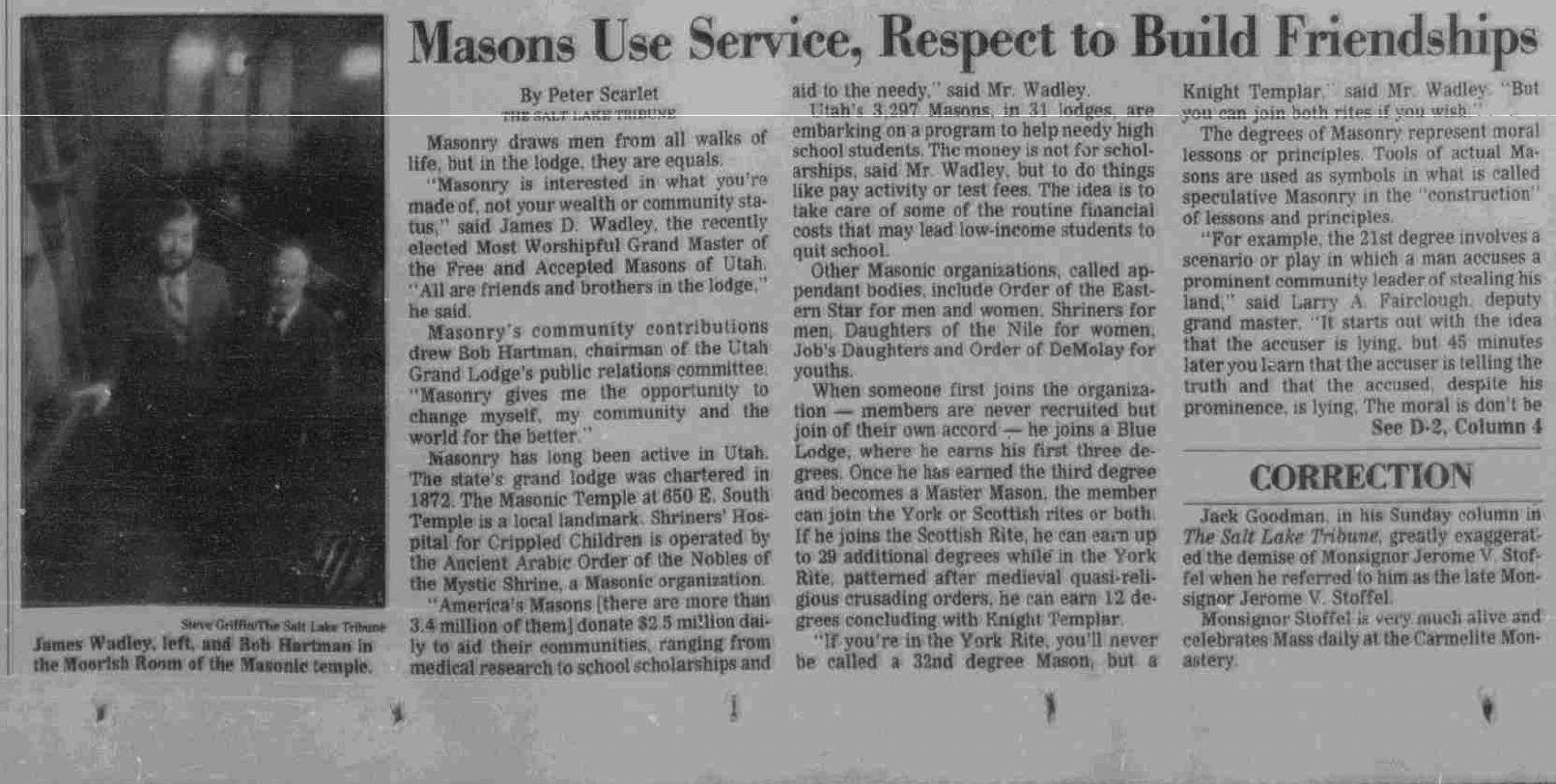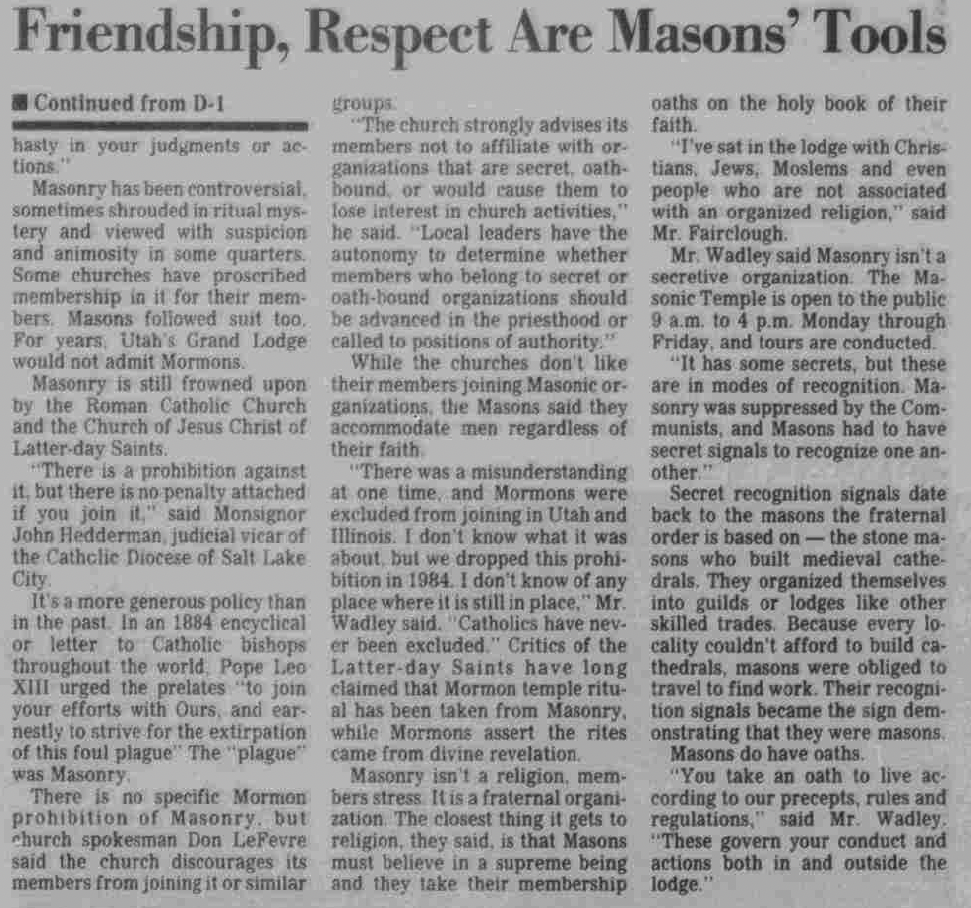Church spokesperson Don Lefevre says that there is no "prohibition against Masonry," but the church "discourages its members from joining."
- Type
- News (traditional)
- Source
- Peter Scarlet
- Hearsay
- Journalism
- Reference
Peter Scarlet, "Masons use service, respect to build friendships," Salt Lake Tribune, February 17, 1992, D1–D2, accessed September 25, 2023
- Scribe/Publisher
- The Salt Lake Tribune
- People
- James D. Wadley, Peter Scarlet, Pope Leo XIII, Larry A. Fairclough, Don LeFevre, John Hedderman
- Audience
- General Public
- Transcription
Masons Use Service, Respect to Build Friendships
By Peter Scarlet
The Salt Lake Tribune
Masonry draws men from all walks of life, but in the lodge, they are equals. "Masonry is interested in what you're made of, not your wealth or community status," said James D. Wadley, the recently elected Most Worshipful Grand Master of the Free and Accepted Masons of Utah. "All are friends and brothers in the lodge," he said.
Masonry's community contributions drew Bob Hartman, chairman of the Utah Grand Lodge's public relations committee. "Masonry gives me the opportunity to change myself, my community and the world for the better."
Masonry has long been active in Utah. The state's grand lodge was chartered in 1872. The Masonic Temple at 650 E. South Temple is a local landmark. Shriners' Hospital for Crippled Children is operated by the Ancient Arabic Order of the Nobles of the Mystic Shrine, a Masonic organization.
"America's Masons [there are more than 3.4 million of them] donate $2.5 million daily to aid their communities, ranging from medical research to school scholarships and aid to the needy,'' said Mr. Wadley.
Utah's 3,297 Masons, in 31 lodges, are embarking on a program to help needy high school students. The money is not for scholarships, said Mr. Wadley, but to do things like pay activity or test fees. The idea is to take care of some of the routine financial costs that may lead low-income students to quit school.
Other Masonic organizations, called appendant bodies, include Order of the Eastern Star for men and women, Shriners for men, Daughters of the Nile for women, Job's Daughters and Order of DeMolay for youths.
When someone first joins the organization -- members are never recruited but join of their own accord -- he joins a Blue Lodge, where he earns his first three degrees. Once he has earned the third degree and becomes a Master Mason, the member can join the York or Scottish rites or both. If he joins the Scottish Rite, he can earn up to 29 additional degrees while in the York Rite, patterned after medieval quasi-religious crusading orders, he can earn 12 degrees concluding with Knight Templar.
"If you're in the York Rite, you'll never be called a 32nd degree Mason, but a Knight Templar," said Mr. Wadley. "But you can join both rites if you wish.''
The degrees of Masonry represent moral lessons or principles. Tools of actual Masons are used as symbols in what is called speculative Masonry in the "construction" of lessons and principles.
"For example, the 21st degree involves a scenario or play in which a man accuses a prominent community leader of stealing his land," said Larry A. Fairclough, deputy grand master. "It starts out with the idea that the accuser is lying, but 45 minutes later you learn that the accuser is telling the truth and that the accused, despite his prominence, is lying. The moral is don't be hasty in your judgments or actions."
Masonry has been controversial, sometimes shrouded in ritual mystery and viewed with suspicion and animosity in some quarters. Some churches have proscribed membership in it for their members. Masons followed suit too. For years, Utah's Grand Lodge would not admit Mormons.
Masonry is still frowned upon by the Roman Catholic Church and the Church of Jesus Christ of Latter-day Saints.
"There is a prohibition against it, but there is no penalty attached if you join it," said Monsignor John Hedderman, judicial vicar of the Catholic Diocese of Salt Lake City.
It's a more generous policy than in the past. In an 1884 encyclical or letter to Catholic bishops throughout the world, Pope Leo XIII urged the prelates "to join your efforts with Ours, and earnestly to strive for the extirpation of this foul plague" The "plague" was Masonry.
There is no specific Mormon prohibition of Masonry, but church spokesman Don LeFevre said the church discourages its members from joining it or similar groups.
"The church strongly advises its members not to affiliate with organizations that are secret, oath-bound, or would cause them to lose interest in church activities," he said. "Local leaders have the autonomy to determine whether members who belong to secret or oath-bound organizations should be advanced in the priesthood or called to positions of authority."
While the churches don't like their members joining Masonic organizations, the Masons said they accommodate men regardless of their faith.
"There was a misunderstanding at one time, and Mormons were excluded from joining in Utah and Illinois. I don't know what it was about, but we dropped this prohibition in 1984. I don't know of any place where it is still in place," Mr. Wadley said. "Catholics have never been excluded." Critics of the Latter-day Saints have long claimed that Mormon temple ritual has been taken from Masonry, while Mormons assert the rites came from divine revelation.
Masonry isn't a religion, members stress. It is a fraternal organization. The closest thing it gets to religion, they said, is that Masons must believe in a supreme being and they take their membership oaths on the holy book of their faith.
"I've sat in the lodge with Christians, Jews, Moslems and even people who are not associated with an organized religion," said Mr. Fairclough.
Mr. Wadley said Masonry isn't a secretive organization. The Masonic Temple is open to the public 9 a.m. to 4 p.m. Monday through Friday, and tours are conducted.
"It has some secrets, but these are in modes of recognition. Masonry was suppressed by the Communists, and Masons had to have secret signals to recognize one another."
Secret recognition signals date back to the masons the fraternal order is based on -- the stone masons who built medieval cathedrals. They organized themselves into guilds or lodges like other skilled trades. Because every locality couldn't afford to build cathedrals, masons were obliged to travel to find work. Their recognition signals became the sign demonstrating that they were masons.
Masons do have oaths.
"You take an oath to live according to our precepts, rules and regulations," said Mr. Wadley. "These govern your conduct and actions both in and outside the lodge."
Caption: Steve Griffin/The Salt Lake Tribune James Wadley, left, and Bob Hartman in the Moorish Room of the Masonic temple.
- Citations in Mormonr Qnas
The B. H. Roberts Foundation is not owned by, operated by, or affiliated with the Church of Jesus Christ of Latter-day Saints.


